The Glassy New Building Coming to Sixth Ave.
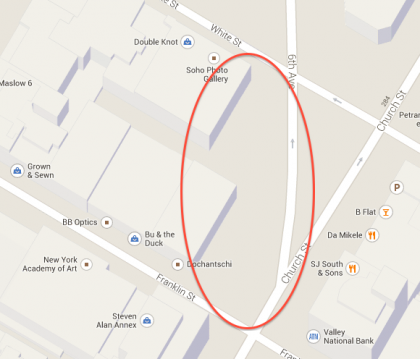 Call it the Two Triangles Building—or better yet, The Remnant: DDG, which also did 24 Warren and the under-construction 12-14 Warren, presented plans at CB1’s Landmarks Committee for an eight-story building—really two buildings that barely connect—on the two triangular parking lots on Sixth Avenue, between White and Franklin. The lots were created in the 1930s, when Sixth Avenue was extended south.
Call it the Two Triangles Building—or better yet, The Remnant: DDG, which also did 24 Warren and the under-construction 12-14 Warren, presented plans at CB1’s Landmarks Committee for an eight-story building—really two buildings that barely connect—on the two triangular parking lots on Sixth Avenue, between White and Franklin. The lots were created in the 1930s, when Sixth Avenue was extended south.
DDG in-house architect Peter Guthrie walked the committee through the design—fascinating, as much for the style as for how much real estate to be worth around here for such a noted developer to bother with these two leftover lots—which would be in the Tribeca East Historic District. As you can see from the map above, it has a full block on Sixth, but the plots take the shape of two triangles, each with its base to the south. They connect with just three inches, and at White, the building comes to a point ten inches wide.
••• The penthouse is meant to evoke the adjacent mansard roofs. It’ll be dark so as not to be glaring.
••• The facade will be four layers: a rain shield of fritted glass, reclaimed brick from the 1800s, metal (I think) structure, and interior glazing with operable windows.
••• The ground floor is retail.
••• They didn’t actually build as high as they were allowed as of right. (One of the diagrams below shows, in dotted lines, how high it could have been.)
••• Cables with ivy trained on them, as in the window at 24 Warren, will be installed at points on the façade.
••• They want potted street trees but they have to get MTA approval.
••• On Franklin, they’re matching the cornice height of the neighbor, 102 Franklin, but at White they’re not (but they’re stepping back a bit).
Members of the committee applauded the way the building dealt with a challenging site, admired the massing of the main part of the building, wondered whether the plantings were contextually appropriate, and actively disliked the penthouse, calling it inappropriate and distracting, with its asymmetrical windows and cantilevered second floor. (They also said it was better than parking lots—am I the only one who likes parking lots?) They questioned the fritted glass—the sample (shown below) was not a final choice—and the black-painted glass for the penthouse (also shown below), wondering if it would all turn into a big black box at night, despite how the renderings show it all transparent and lovely. Guthrie said they’re looking for “DDG gray” for the penthouse, and they think the vines are reminiscent of weeds growing through cracks in the sidewalk. (Am I the only one who thinks the ones on Warren look sort of unhappy?)
The neighbors are concerned about how their buildings will survive—17 White is still doing repairs from Sandy—but the committee assured them that DDG and its structural engineer were the best possible neighbors. There was also concern about how much light would make it into the air shaft—rightly so, I’d say, and those are some of the best trees in Tribeca.
The committee voted 9-0 to pass a resolution asking DDG to rework the mansard and reconsider the bulkhead. All of this is advisory to the Landmarks Preservation Commission, which will discuss the project on Nov. 12. It apparently also must go before the CB1 Tribeca Committee for a variance from the Board of Standards and Appeals because in this area they’re only allowed 80 percent of lot coverage and they need more because it’s so small and strange.
Update: The first image below is a rendering sent over from DDG (as opposed to the others, which are my crappy photos of renderings). Also, the word is that current plans have it at 11 units. Finally: The more I look at it, the more I like it. Although why the renderings don’t show 56 Leonard—which provide it some contemporary context—is a mystery. Because it doesn’t exist yet?
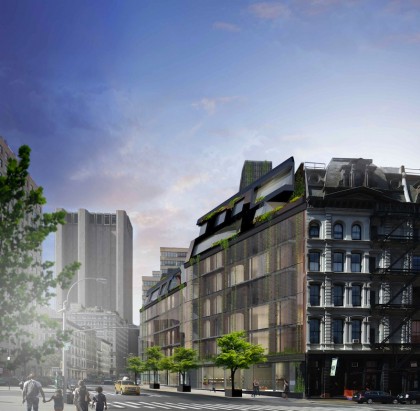
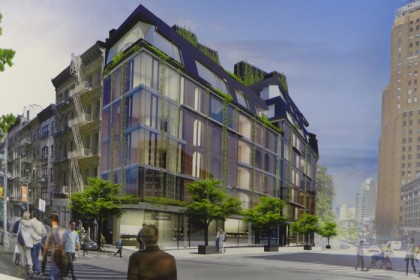
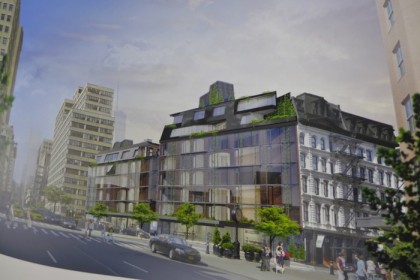
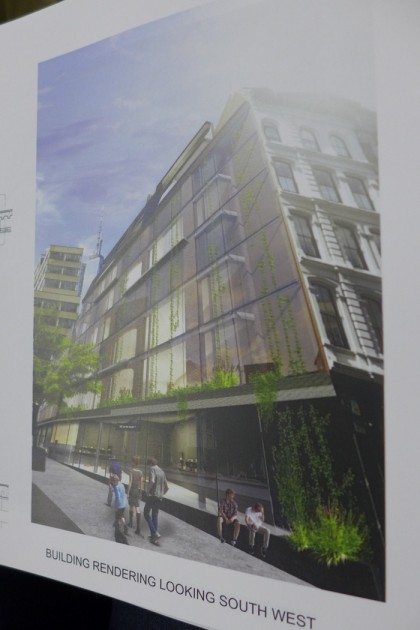
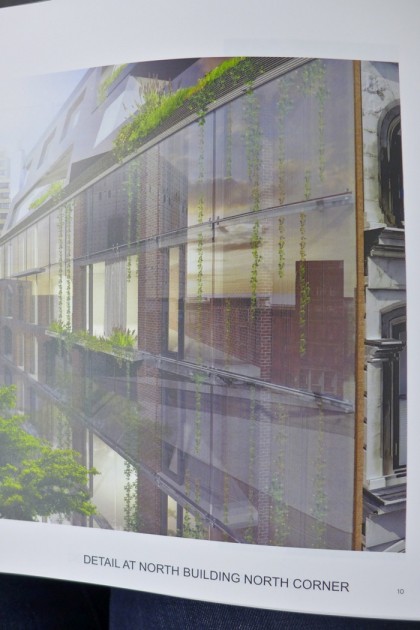
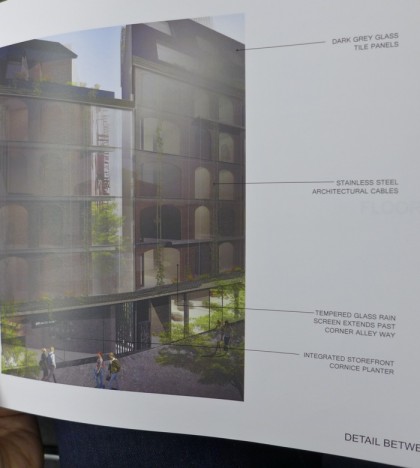
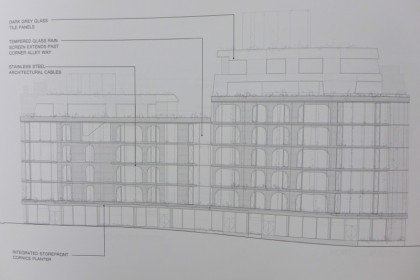
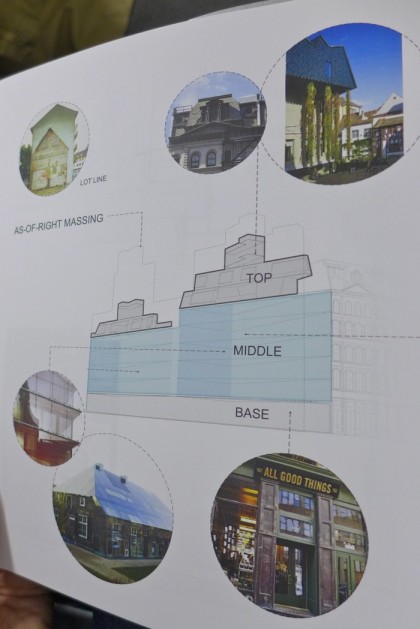
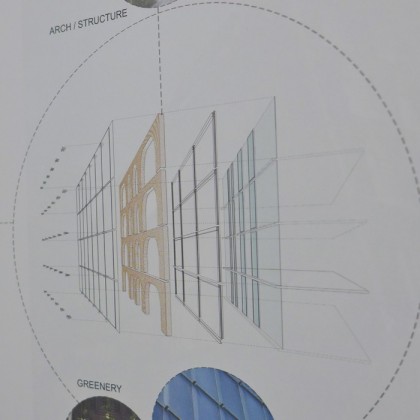
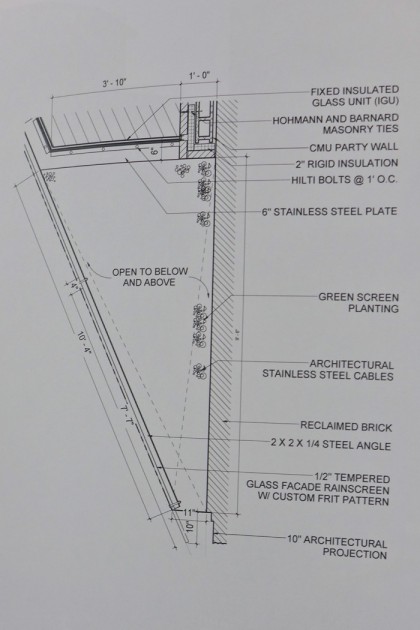
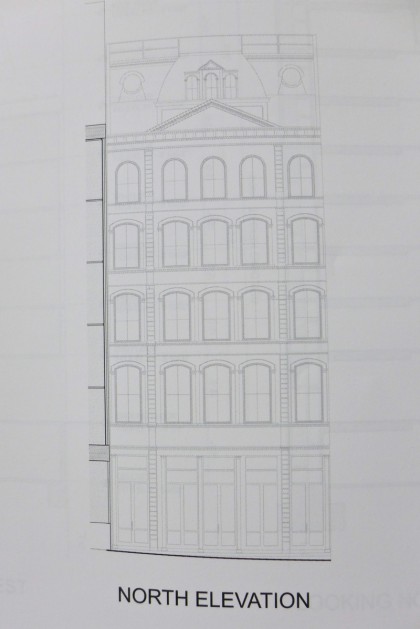
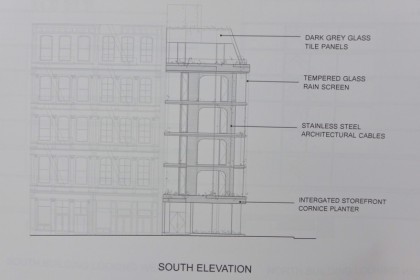
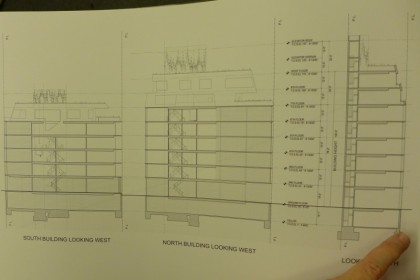
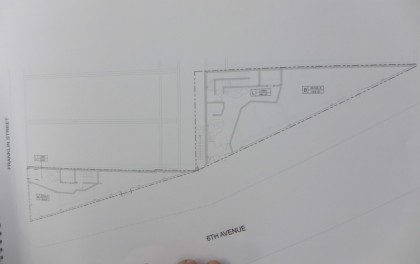
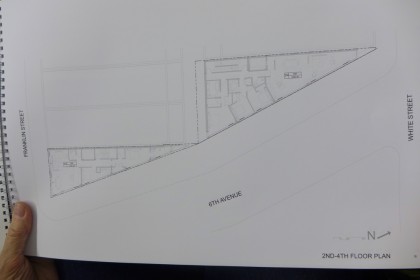
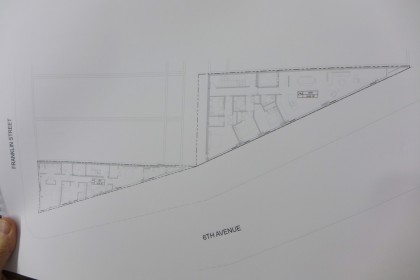
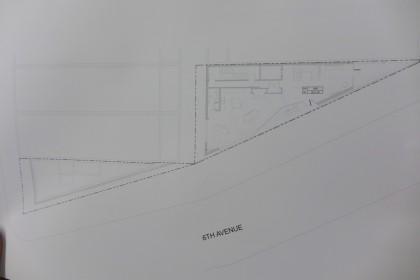
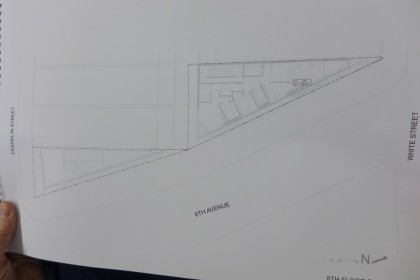
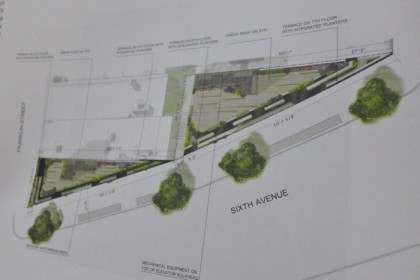
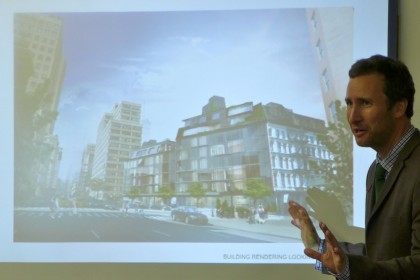

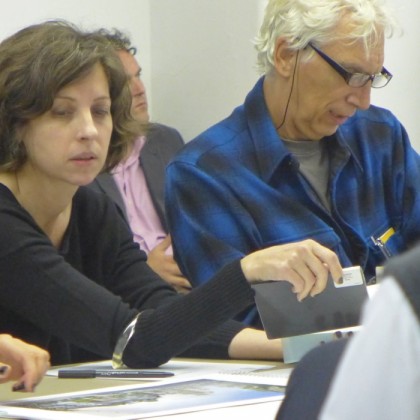 Walked by and took some photos of it now:
Walked by and took some photos of it now:
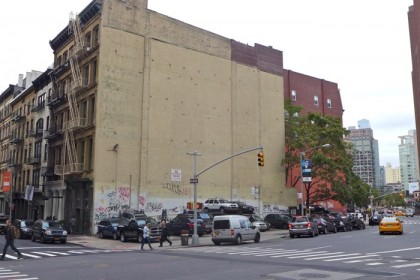
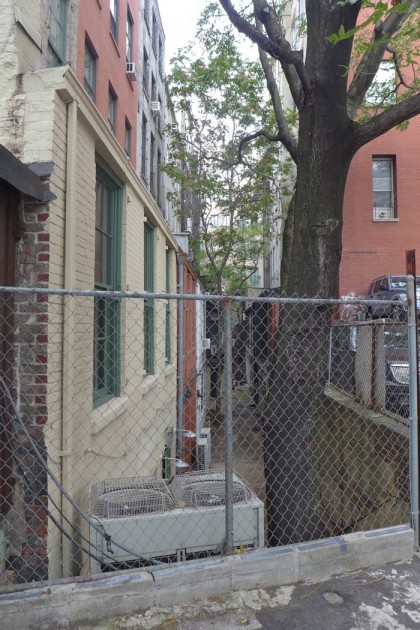
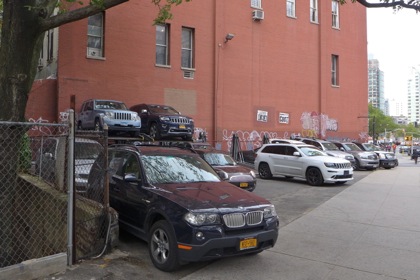
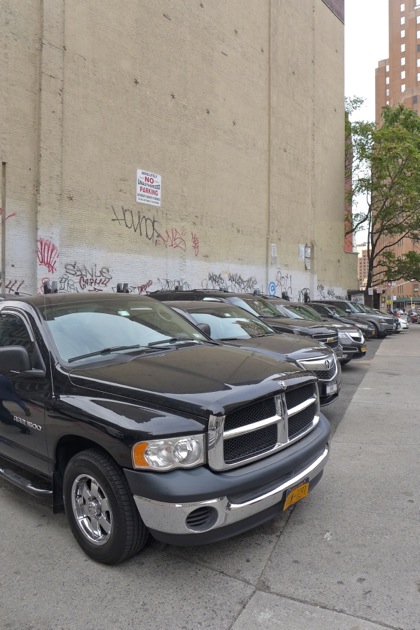 And here’s how those 24 Warren vines are working out.
And here’s how those 24 Warren vines are working out.
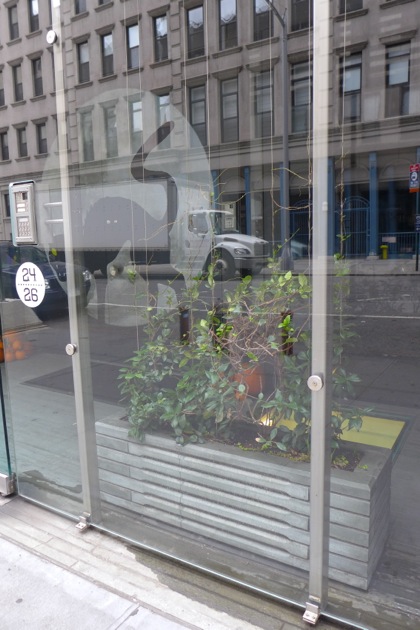 Update: Comments have been turned off due to spam. To have them turned back on, email tribecacitizen@gmail.com.
Update: Comments have been turned off due to spam. To have them turned back on, email tribecacitizen@gmail.com.













I love bringing more neighbors to the ‘hood but I need my affordable week-day parking in these lots. I’m with you Erik, I like my parking lots! We’re we just discussing a parking shortage in TriBeCa?
@H.H. We were indeed! For me, it’s not the parking so much as the openness that lots provide. But I guess that’s life in a real-estate boom.
Absolutely think it is horrendous what they are doing to this small open lot — what about the people with windows at 13-19 White — I can understand building against the Franklin St Building –not blocking anyone’s sunshine and good humor — why can’t they be considerate and keep the Church/White section for parking — parking in that area is hard anyway — if the developers are so money hungry — sell the parking spaces to the new building owners and the White St owners — you can easily make a double height open elevator garage, sell the spaces, keep some open feeling and everyone is happy — totally disgusted
So much hate. I think new (nicely done) developments are great. Yeah, there isn’t much parking, but comes with the territory. I’d rather be in area with booming new luxury construction than saving an extra 40 private parking spots. These renderings looks great. Plus I’d rather see new luxury buildings than double-height mechanical parking lots. That’s more of an eye-sore in my opinion.
Also, those are all land-lot windows. The reality residents in those buildings were lucky to have those windows with great light and views for this long. It does suck for the owners there, but t’s not like the new construction is blocking legal windows, any owner there would know it was always a possibility. If that was the case, a lot of new construction would never happen.
Hey, that’s my parking lot and I like it just fine. More importantly, 17 White Street is my home, for over 23 years. Without commenting on the stand alone aesthetics of the proposed construction, I will say that I am shocked to see that this design is even being considered. I am proud of our supposed historic district and every day I see it being ripped apart by “luxury construction”. What do I see when I look at this design slapped over my building? I see an architect’s super-sized ego and a greedy developer’s bank account.
It is an insult to the historic district that the project will use “reclaimed brick from the 1880s” behind the “fritted” glass facade and that the proposed penthouse will be “black glass to match the mansard roofs”. Our classic mansard roof happens to be clad in bronze sheeting which we have carefully restored. We are a historic district after all. I really do believe that we are so fortunate to live in such a beautiful area of New York that should be preserved for residents and visitors alike. When will Tribeca really have a voice in making reasonable decisions about new construction?
I personally believe that we should hunt mammals with sharp sticks and eat their flesh raw to pay homage to our historical origins. After all, we live in a historic district [ http://tinyurl.com/njdw8fa ].
@David: It’s like CrossFit meets the paleo diet!
The “Two Triangles” building just doesn’t add up. The developer, DDG, will be asking for variances on the North parcel because the planned structure is totally inappropriate in both scale and context for a minuscule parking lot.
As a resident of 17 White Street, I am saddened by the “If you build it, they will buy it” attitude that seems to prevail on our Tribeca East Historic District. While it may be a creative design, the 1867 loft building that I live in with my family will be severely compromised architecturally and possibly structurally as the tiny lot morphs into a vine covered glass menagerie.
The angles of a triangle are supposed to add up to 180 degrees, not the 360 that DDG is trying to extract from the community.
P.S. Forgot to mention that the tree that will be chopped down to make way for the glass extravaganza trumps those old vines any day…
There is a very important principal at stake with the 100 Franlin St project: does DDG have to live by the same laws as everyone else? DDG is seeking not one but two zoning exemptions, when the only discernible reason for the exemptions is to sell more square footage. What is the point of zoning laws if a developer can obtain an exemption when more money can be made? Rumor has it that DDG is paying nearly $10 mm for the lot, so the exemptions are key to DDG’s ability to sell an absurdly priced penthouse and make an equally absurd profit. Who benefits from this? Not Tribeca, not the historic district, but certainly DDG.
@brad: You’re speaking to the fundamentals of NYC’s current financial dynamics, a capitalist engine with no evident governance, threatening to blow apart from its own entropic energy. That’s according to some observers. If you ask Michael Bloomberg, who mused recently in print about how delightful it would be if all the Russian plutocrats moved to NYC, “who benefits,” his answer would be you (and all NY’ers), whom he perceives as living better lives because his policies have facilitated an influx of inordinately wealthy property-holders (if not necessarily residents) to the city. I’ll leave the math on that to others, but to say that many find it tenuous at best.
I happen to like what I can see of the building, though.
We are dismayed by the scale and character of the building proposed for the 100 Franklin Street lot(s). A continuous curtain wall of glass running over 200 feet in length and six stories high is unprecedented in the Tribeca East Historic District and completely out-of-context with the neighboring buildings, all constructed of stone, cast iron and brick. Across the street and down the nearby blocks, the building facades are generally 20 to 60 feet wide at most (the one exception being the new Tribeca Grand Hotel). Just look across Church at the street front between White and Franklin on the east and see the visual variety, the real character of Tribeca. Atop the glass curtain wall is to be an aggressive, thrusting, angular black-glass encased penthouse, partly cantilevered outward rather than set back. From the drawings the penthouse looks like a Soviet-era Constructivist nightmare and, together with the grandiose glass curtain wall below, speaks only of the architect’s hubris and arrogance. The architect has not even taken pains to make the roof top mechanicals other than rawly conspicuous. (At the CB1 meeting, the architect and developer acknowledged they had not been aware that the building at 13-19 White Street had been sliced back to allow for the subway and extension of 6th Avenue and that this building’s east wall had originally been an interior wall: so much for their research into and sensitivity to the site.) It has also been proposed to fully cover the 13-19 White Street building east wall, all the way to the unusable triangular north tip, with “reclaimed” red brick, thus covering up the real original brick with an ersatz brick skin, a piece of theater. Why blot out the original???? The northern elevation of the proposed new building shows the weirdest, ugliest fusion, or gluing, of an extremely skinny six-story strip of glass to the grand old cast iron facade, that makes no architectural, aesthetic or historic sense whatsoever. The especial beauty of the 13-19 White Street building’s northeast corner, stretching from its handsome mansard roof down both its cast iron face and its pink-brick exposed wall will be destroyed. One can now stand back and take in that beautiful mansard cornice and its stem. And there is absolutely no need for a new building to consume bits of unusable triangular land at either the north end of the Franklin parcel or the north end of the White-Street parcel, with the developer asking for a variance to escape the 80%/20% zoning law (a law requiring 20% of the lot to be left unbuilt). Add to all this, the fact that the curtain wall will drastically, if not completely, block the light down the alley to all the buildings on this Franklin/White block and will wholly erase the wonderfully interesting, characteristic and historic view through the trees down that broad back alley. We were told the proposed building’s ground floor would be retail/commercial, and we believe the true street-side effect — with that enormous glass curtain wall backed by synthetic brick arches — can only be that of a suburban shopping mall. And WHO, in heaven’s name, will be tending those much-touted vines seven or ten or 25 years from now? The greenery is only an ephemeral garnish. Please, powers that be, don’t let this alien phenomenon land in our protected neighborhood.
Dear Neighbors,
In no way does this building belong in one of Tribeca’s historic districts. I wish I had been at the meeting to say so. This design defeats the purpose of historic district designation. Within the boundaries of the districts, in-fill should use the existing architectural language of the surrounding older buildings, and no, the top floor does not look like or render homage to the existing mansards next door. The above poster is quite correct that it looks Soviet. The need for variances says it all. I am very sad that this got through a first level committee and I dislike having to disagree with my neighbors who let this through at the community board. I wish they had just sent the architect back to the drawing board. At its most simple, curtain walls simply do not belong inside the district, they arise from a modernist language that does NOT blend or harmonize with the masonry world of Tribeca. Le Corbusier gave a dictate to architects in 1927: “use only curtain-wall”. Why listen to him? He was a destroyer of historic districts. We cannot let him win.
I feel completely confident that this kind of experimentation and (failed) attempt at architectural creativity is not appropriate to this site. Stepping back, I see that one of the problems is that NYC has no good standards for in-fill. Officialdom is winging it on no published set of criteria or standards for historic district in-fill. They are just applying vague personal opinions. Well, there is a “manual” for Tribeca West that LPC produced, but it speaks to existing buildings, not in-fill.
My view is this: within historic districts, the harmony overall of the historical built environment is preserved for good reason. Moreover, it is meant to visually prevail while walking through the district. That is the public good we are paying for when we designate a district and it is the law of the land. Therefore, at a minimum, in-fill must not only be contextual, it should not draw attention to itself. This design fails on all these levels. It is not contextual. It attempts to draw attention to itself away from the surrounding district. And it is not historicist in intent. It does not use Tribeca’s existing architectural language to make the design. A masonry design would be a better and more appropriate attempt at that.
The fact of the matter is that the best in-fill IS truly historicist in character, such as at 154 Reade or 124 Hudson. I know that architects who imagine themselves as artists normally dislike being compelled to use a historicist language (and feel instead compelled to follow Le Corbusier for some reason I cannot understand). They use the word with contempt. But I say to them: too bad, within historic districts, historicism is the name of the game. Doing so would not be Disneyfication, nor would be it be kitsch or ersatz. At its best, as 154 Reade and 125 Hudson show, we get low-key elegance that blends in contextually to the rest of the neighborhood. This one cries, “oh look at me, I’m different than everything else in the district.” That is architectural arrogance, which belongs elsewhere (maybe) but not here for certain.
Best,
Lynn Ellsworth
Chair, Tribeca Trust http://www.tribecatrust.org
Should have thrown into the comment above: the skins (see drawings) just don’t work here.
Lynn
A correction: the elegant, contextual, “historicist” in-fill buildings on Reade Street that I am talking about are 148, 150, and 152 (the three townhouses by John Petrarca I think).
It is a deep mistake to put this kind of discussion on the level of personal aesthetics, meaning “I like it” or “I don’t like it”, although it is refreshing that on a commercial blog like this the editorial biases are at least made clear to the public, whereas they are more often disguised and given masks in places like the Times, Crains, the WSJ or say The New Yorker. In so much of the press dependent on or angling for real estate advertising, a destructive modernist agenda makes carefully coded arguments for feverish, unregulated, incoherent building behind words like “density” and “urban design” and “architectural creativity”.
In situations like this, personal opinions are really not relevant. Putting design on a personal taste issue avoids what is important about the situation: there is a public policy issue at stake here. What constitutes appropriate in-fill within historic districts. Who makes that determination? Are they doing a good job of it? Is the system working as it was intended? Are there guidelines that the inhabitants of a historic district agree on? Historic districts are legally regulated entities. Alas, as the case of Tribeca shows, regulation has been weak, the regulatory system spectacularly under-funded. The community boards which are the very lowest level of the system have to operate without guidelines. They are given a massive amount of work that must be rushed through without proper public discussion, while mired in their their own often poorly understood biases. The problem is city-wide. From higher up in the regulatory system, we seem to get only vague philosophizing about contextual development, which is a good start but is not a substitute for better specified regulation. There has been a policy void on this specific issue for a long time. I hope that a new landmarks commission in the next administration will find the time to address this void.
I would also add that 56 Leonard is irrelevant. 56 Leonard is not in the historic district and thus cannot provide relevant “context” for an in-fill site within the district.
I guess the matter of whether the concept of a “historic district” is the least bit meaningful or useful to a progressive society is entirely off the table. I know that it sure helps societies preserve old wealth. Beyond that (and perhaps this is my failing) I cannot fathom fierce obstinacy about preserving in amber obsolete structures that aren’t intrinsically valuable as aesthetically challenging or innovative, and are in fact mostly banal in the extreme. I live in such a building (cast iron facade) but don’t fancy that it’s the equivalent of any architectural artifact that anyone would devote any time whatever to studying. I’ll have to refrain from future commentary on matters like this, as I appear to be a minority of one.
Mr. Imber,
Your use of the phrase “preserved in amber” suggests to me that are confusing the idea of “curatorial preservation” with “urbanist preservation”. Has someone gone around telling you to “preserve in amber” your building? Somehow I doubt that very much. A curatorial preservation approach would be about presenting a house or structure as a museum piece. You might mean that I think. “Preserving in amber” would probably also mean not allowing you to live normally in the structure or forbidding you to put in new windows or to rent the ground floor to an ever changing cast of commercial renters. The LPC hardly takes that approach to historic districts. The phrase is a canard or a “red herrring” used to confuse and disguise the issues so as to favor inappropriate real estate development.
I also think you are mixing up a lot of concepts and issues and throwing around terms that have little meaning. How do you know if a structure is obsolete? Who in fact claims it to be obsolete? Do they have some financial stake in the matter? David Rockefeller for example decided that the entire Washington Market area was obsolete and should be destroyed. He succeeded over the wishes of hundreds of businesses and residents who did not see their buildings as obsolete. They were all kicked out and replaced with what Rockefeller and his friends wanted to build. And what constitutes the idea of “aesthetically challenging”? A Le Corbusier building that even the owners wanted to tear down because they themselves realize it was uninhabitable? And who determines if a structure is “innovative”?
I also find that the fiercest advocates for destruction tend to be those who gain the most from it: real estate developers, and architectural ideologues who represent the forefront of what we could call an”architectural-real estate development complex” that just want more contracts and thus have a strong need to churn the bricks so to speak.
A rickety six-floor walk up with no soundproofing or fireproofing, that had to have waste and heat systems shoehorned into it, that was once an adequate storage facility for several hundred bolts of fabric but never intended to be resided in, is obsolete in a residential milieu. Perhaps the semantics are obscuring the issue. If one can find one of those goofy-looking old bicycles with the gigantic front wheel and the teensy back wheel, it may be possible to ride it. But I think anyone could be forgiven for saying that as a bicycle it is obsolete.
As for being preserved in amber, that’s of course a figurative term, meant for effect. The owner of my building is, in fact, restricted from making all sorts of cosmetic changes to it. Yes, we can put in new windows, as long as they match the old ones. LPC would indeed forbid the owner of my building from knocking out the framework and installing floor to ceiling glass panes. He would also not be able to paint the building hot pink, as far as I know. I am not intimately familiar with all the restrictions on construction in my historic district, but they are extensive. “…amber” was used as a rhetorical device, but I really don’t think it was far off the mark.
I don’t mean to get into a heated dispute, certainly. I have no part in any of these fights. But I recall not long ago when someone on Leonard St. wanted to build a new glass and steel building between W. Bway and Hudson, and preservationists argued about every aspect of it – height, materials, coloration… Ultimately, as I recall, the developer acceded to various demands that had to do with aesthetics, without question, and even more to do with certain property owners arguably losing a bit of daylight. This all feels to me like fighting the course of architectural progress and preserving old structures that were never even meant as residences because people have sunk money into them, not because they satisfy practical needs of modern urban dwellers.
My father was born in 1912 in a building on 7th Street near Avenue B – what was then a Jewish immigrant enclave. I’m sure someone is paying lots and lots and lots of money to live there now. I’m equally sure that, were he alive, my father would have no interest in preserving for its “historical importance” the crap hole his family was forced to live in because they were poor immigrants. But at least it was intended from the first to be a residence, in a residential neighborhood that has never been anything but. And despite its shoddiness, at least it wears that mantle viably. As such it has 10x more charm as a dwelling than the former sweat shop I’m living in. I’m overjoyed to live here, don’t get me wrong. But if I owned the building and wanted to knock it down to put up a high-rise in glass and steel that would be a comfortable efficient dwelling for many more people, that could stand through the next century, I could not. I don’t think it’s inappropriate for me to think of that as preservation in amber.
PS: re: Washington Market. I respectfully defer to your knowledge of the history of that area, but it’s a matter of fact that the market thrived at a time when boats pulled up to piers there to drop off goods. The men who worked those boats, I’m told, actually stayed in the Cosmopolitan Hotel in its former life, while in town. The Hudson is no longer a freeway for transporting goods, and there’s no longer the need for a market at the edge of the harbor. Again, I’ll defer to your historical knowledge, but I do believe that’s the definition of obsolescence.
I’ve written about the High Line, Chelsea Market, and Dia:Beacon. The connection here is that there was a time when companies that were big enough paid for spurs off the main railroad thoroughfares to do their business. Nabisco built a box factory in Beacon that is now a museum. They built a spur off the railroad bed that brought those boxes to their bakery and distribution center, which is now an office and studio building and Chelsea Market. That spur is now a park. These things are obsolete as what they were, but enhance life for a large segment of society as what they are. It is hard for me to imagine the same argument being made for a residential building in our neighborhood that’s merely quite old.
Various thoughts arise from your note:
1. So you live in an old un-renovated loft building with a cast iron facade that nobody has put money into fixing up? So the owner of your building refuses to insulate it and put in proper plumbing? Does that mean that such a loft building cannot be fixed up and rendered habitable? I doubt it. Many, many loft buildings all over lower manhattan have been renovated to provide comfortable homes, some quite simply, some quite expensively, depending on who did the conversion and when. Actually, many very good architects think of loft buildings as extremely flexible spaces. They can accommodate commerce, manufacturing, salesrooms, simple homes, store-rooms, workshops and yes, even elegant homes. Retrofitting them for residential purposes is not that hard from an architectural point of view. Sounds like the owner of your building just doesn’t want to. Then we are into another and longer discussion about the economics of conversion and landlord-tenant relationships.
2. I live in the historic district and don’t think LPC is making my co-op preserve our building in amber. The “preserve in ambler” phrase is misleading exaggeration and hyperbole and does not make the argument you seek. REBNY, however, loves to use it: they are itching to destroy the historic districts and build skyscrapers and say so at every turn, quite obviously to line their own pockets rather than provide for the public good.
3. Washington Market was only obsolete if you were David Rockefeller. Food came in by rail and truck as well as boat. People in the market hatched perfectly valid plans to continue doing their work here and even to expand. They were prevented from doing so. The Longshoremen on the other hand may have become obsolete with the advent of containerization, but not the market itself.
4. Not sure I get the references to the High Line etc. The buildings you mention are examples of adaptive re-use, consistent with an urbanist approach to preservation. Those buildings are only made stronger and more interesting within the context of a historic district.
5. Either you agree with the concept of a historic district or you don’t. Either you attach value to the urbanist form such a district represents and want to enjoy the public commons such a designated district creates or you don’t. I get the feeling you don’t . But most New Yorkers do want it. How else can you explain the creation of the Landmarks Law in the face of massive opposition of the much wealthier and more powerful real estate industry? In the case of historic districts, the city, through normal democratic processes, made the creation of historic districts a normal part of urban life and the law. They are rightly declared a public good, which they are. People wanted them. People still want them. That means that there are lots of people who do see beauty and value beyond the square footage of an individual building where you might not.
6. I think you are saying that “ordinary” old buildings should not be allowed into a district, and that only architecturally unique ones should be allowed in. That is an old-fashioned curatorial or “specimen” approach to preservation: collect a sample of each species and you are done. That is what creates weird islands that look bizarre. That is what ends up creating a kitchy Disney feel or in some cases a creepy forlorn experience, because the site is all alone, out of context. We need the ordinary old buildings to create the actual context of a historic district.
7. The architect and historian Robert Stern made the point about Tribeca when he wrote the LPC with these words: “Is broadly defined area designation preferable to scattered individual designation [of landmarks]? In the case of Tribeca, I think the answer is clearly yes; as in other great New York neighborhoods, the total is far more than the sum of its parts. Even the most masterful urban buildings are not isolated icons, but part and parcel of the larger matrix within which they must be evaluated. While the protection of individual significant buildings is important, it is only within the context of scores of less distinctive but nonetheless skillfully conceived “everyday masterpieces” that they collectively present a powerful reflection of of New York’s mercantile and industrial past”.
I am also quite sure I do not know what is meant by “architectural progress”. If that means glass curtain-wall everywhere, I fail to see the progress part. Curtain wall has been around a long time now and hardly represents innovation. If you are talking “green” technology, I’d bet that an older masonry building outperforms most of the curtain-wall high rises anytime.
” Either you agree with the concept of a historic district or you don’t.” Yes, and I said that was why I’d refrain from future comment on this, but I disobeyed myself. Thank you for the discussion though!
Tribeca Neighbors,
I’m really concerned that this project seems to have moved along so quickly and the community has just recently learned about it. I’ve always had the understanding that the ‘community’ has a chance to voice their suggestions and concerns at Community Board meetings, so, hopefully all Community Board-1 members/volunteers will spend time reading these posts since I heard community microphone time was extremely limited at the sub-committee meeting on October 10th.
Below are my biggest concerns with proposed 100 Franklin Street. Please take a moment to read and think about them. And, if you agree, please join us on Tuesday, Oct 22 @ 6pm at 150 Chambers Street.
-The reflective nature the glass wall curtain and the very busy intersection for both drivers and pedestrians really worries me. When the sun rises from the East, the light is blinding. Vroom…vroom…Ouch! “Where’s the nearest Sunglass Hut?!”
-How about those two giant rooftop mechanical boxes? I’d appreciate some time to review the interior design of those to make sure they can’t be occupied. If they CAN be occupied I don’t believe they should be visible from street level. And, if they CANNOT be occupied, I believe they are supposed to be ‘minimally visible’. As currently displayed in the rendering, they can likely be seen for miles, well, at least several blocks. And those pretty green vines can’t possibly hide those monstrosities. I recommend absorbing those giant mechanical bulkheads into the penthouse, lose some penthouse square footage, and make a few less dollars. It would certainly look at whole lot better in our historic community.
-What happens to the alley between White and Franklin Street properties? How would the Fire Department get access? Is there any chance that alley is a primary form of emergency egress for White and Franklin Street buildings? From the looks of the rendering, a wall that cannot be occupied would connect these two buildings and block that alley. Yep, a wall could be what separates safety and fire hazard in that alley. I’d like to learn more here since there is no way out towards West Broadway, so, the only other option could be asking, “Hey, does anybody have a trampoline so I can jump over that wall?”
-As the Tribeca Citizen contributor mentions in the opening paragraphs, the MTA needs to approve those trees along 6th avenue. So, I request that those are removed from the plans since no approval has been granted yet. Take away that greenery and you’ll notice much more cold reflective glass in a warm bricked Historic Tribeca neighborhood.
-Finally, if the square footage of each building section is 2,000 square feet or more, there needs to be two emergency egresses. Currently, even the larger slice of the pie only shows one. I’d like some time to make sure that this square footage is accurate to ensure that if a building does get constructed, it’s a very safe building that meets all necessary building code requirements. I’ve always been told–safety first.
Tribeca friends and neighbors, I really wish we could all come together and buy these lots to install a dog park and/or outdoor market for local artists and designers. But, I think we’re too late. These types of creative ideas are the ways we really should be thinking about preserving and expanding Historic Tribeca.
Community Board-1 Meeting:
Date: Tuesday 10/22
Time: 6pm
Place: 150 Greenwich Street
IMPORTANT: The community will be heard at 6pm sharp.
And please bring your children dressed up as dead pigeons or as big blue bottles of Windex to better illustrate the fact that this glass curtain will be a death trap for pigeons that don’t appreciate the nuanced reflective properties of the glass curtain, as well as the massive monthly supply of Windex that will be needed to keep this glass squeaky clean (and to clean up the pigeon brains).
Obviously, I don’t agree with Madame Ellsworth because when she uses her code word and safe word “masonry,” she really means cobblestones. And everybody knows that you can’t use cobblestones on building facades. If she could, she would.
Also, for the Criminal Summons Court, please bring your children dressed as pimps, junkies, and crack whores. Please leave the apple juice filled syringes at home.
I love how are community exploits their children for the greater good.
For Halloween, my daughter is going dressed as a Tribeca Dad – baseball cap, white t-shirt, black puffy North Face down vest, cargo shorts and flip flops.
I am going dressed as a troll. It’s not really a costume, but…
Tribeca Neighbors,
Tonights Community Board-1 Meeting to discuss 100 FRANKLIN STREET is being held at 150 GREENWICH STREET at 6pm.
As you can see from many of the posts above, there are some questions and concerns about this pending development. The meeting begins at 6pm tonight and below are directions to help you arrive there on time. The community will have a chance to speak at 6pm sharp, so, please don’t be late.
WALKING FROM POINTS NORTH:
Head straight down Church Street ( it turns into Trinity PL) to Liberty St.
Turn right on Liberty.
Head over one block to Greenwich St. You enter just there. (The building looks like it is still under construction.)
SUBWAY:
Take the E train to WTC stop.
Exit on Church Street (Trinity Place) and follow above directions.
TAXI:
Take TAXI down Broadway to Liberty.
Walk across Liberty to Greenwich St.
We look forward to hearing your comments.
Please let my daughter speak first, if she has to wait too long she is going to lose it!!
I have also talked with the Community Outreach Officer at Precinct 1 and they have agreed to suspend any stroller parking restrictions, as the stroller turnout is expecting to be heavy.
I have also made plenty of extra signs that read: “EXPLOIT OUR CHILDREN, NOT OUR NEIGHBORHOOD!”
My apologies, that should have been a comment for the Occupy Criminal Summons Court thingy. How embarrassing.
Anybody has any knowledge if what’s going on with this project? There’s a hearing on nov 12th I believe